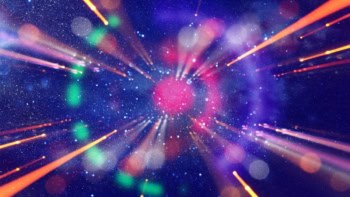
Researchers in Japan have developed what may be the first string-theory model with a natural mechanism for explaining why our universe would seem to exist in three spatial dimensions if it actually has six more. According to their model, only three of the nine dimensions started to grow at the beginning of the universe, accounting both for the universe’s continuing expansion and for its apparently three-dimensional nature.
String theory is a potential “theory of everything”, uniting all matter and forces in a single theoretical framework, which describes the fundamental level of the universe in terms of vibrating strings rather than particles. Although the framework can naturally incorporate gravity even on the subatomic level, it implies that the universe has some strange properties, such as nine or ten spatial dimensions. String theorists have approached this problem by finding ways to “compactify” six or seven of these dimensions, or shrink them down so that we wouldn’t notice them. Unfortunately, Jun Nishimura of the High Energy Accelerator Research Organization (KEK) in Tsukuba says “There are many ways to get four-dimensional space–time, and the different ways lead to different physics.” The solution is not unique enough to produce useful predictions.
These compactification schemes are studied through perturbation theory, in which all the possible ways that strings could interact are added up to describe the interaction. However, this only works if the interaction is relatively weak, with a distinct hierarchy in the likelihood of each possible interaction. If the interactions between the strings are stronger, with multiple outcomes equally likely, perturbation theory no longer works.
Matrix allows stronger interactions
Weakly interacting strings cannot describe the early universe with its high energies, densities and temperatures, so researchers have sought a way to study strings that strongly affect one another. To this end, some string theorists have tried to reformulate the theory using matrices. “The string picture emerges from matrices in the limit of infinite matrix size,” says Nishimura. Five forms of string theory can be described with perturbation theory, but only one has a complete matrix form – Type IIB. Some even speculate that the matrix Type IIB actually describes M-theory, thought to be the fundamental version of string theory that unites all five known types.
The model developed by Sang-Woo Kim of Osaka University, Nishimura, and Asato Tsuchiya of Shizuoka University describes the behaviour of strongly interacting strings in nine spatial dimensions plus time, or 10 dimensions. Unlike perturbation theory, matrix models can be numerically simulated on computers, getting around some of the notorious difficulty of string-theory calculations. Although the matrices would have to be infinitely large for a perfect model, they were restricted to sizes from 8 × 8 to 32 × 32 in the simulation. The calculations using the largest matrices took more than two months on a supercomputer, says Kim.
Physical properties of the universe appear in averages taken over hundreds or thousands of matrices. The trends that emerged from increasing the matrix size allowed the team to extrapolate how the model universe would behave if the matrices were infinite. “In our work, we focus on the size of the space as a function of time,” says Nishimura.
‘Birth of the universe’
The limited sizes of the matrices mean that the team cannot see much beyond the beginning of the universe in their model. From what they can tell, it starts out as a symmetric, nine-dimensional space, with each dimension measuring about 10–33 cm. This is a fundamental unit of length known as the Planck length. After some passage of time, the string interactions cause the symmetry of the universe to spontaneously break, causing three of the nine dimensions to expand. The other six are left stunted at the Planck length. “The time when the symmetry is broken is the birth of the universe,” says Nishimura.
“The paper is remarkable because it suggests that there really is a mechanism for dynamically obtaining four dimensions out of a 10-dimensional matrix model,” says Harold Steinacker of the University of Vienna in Austria.
Hikaru Kawai of Kyoto University, Japan, who worked with Tsuchiya and others to propose the IIB matrix model in 1997, is also very interested in the “clear signal of four dimensional space–time”. “It would be a big step towards understanding the origin of our universe,” he says. Although he finds that the evolution of the model universe in time is too simple and different from the general theory of relativity, he says the new direction opened by the work is “worth investigating intensively”.
Will the Standard Model emerge?
The team has yet to prove that the Standard Model of particle physics will show up in its model, at much lower energies than this initial study of the very early universe. If it leaps that hurdle, the team can use it to explore cosmology. Compared with perturbative models, Steinacker says, “this model should be much more predictive”.
Nishimura hopes that by improving both the model and the simulation software, the team may soon be able to investigate the inflation of the early universe or the density distribution of matter, results which could be evaluated against the density distribution of the real universe.
The research will be described in an upcoming paper in Physical Review Letters and a preprint is available at arXiv:1108.1540.



